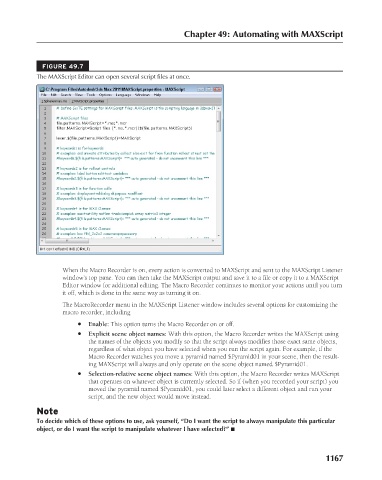Page 1215 - Kitab3DsMax
P. 1215
Chapter 49: Automating with MAXScript
FIGURE 49.7
The MAXScript Editor can open several script files at once.
When the Macro Recorder is on, every action is converted to MAXScript and sent to the MAXScript Listener
window’s top pane. You can then take the MAXScript output and save it to a file or copy it to a MAXScript
Editor window for additional editing. The Macro Recorder continues to monitor your actions until you turn
it off, which is done in the same way as turning it on.
The MacroRecorder menu in the MAXScript Listener window includes several options for customizing the
macro recorder, including
l Enable: This option turns the Macro Recorder on or off.
l Explicit scene object names: With this option, the Macro Recorder writes the MAXScript using
the names of the objects you modify so that the script always modifies those exact same objects,
regardless of what object you have selected when you run the script again. For example, if the
Macro Recorder watches you move a pyramid named $Pyramid01 in your scene, then the result-
ing MAXScript will always and only operate on the scene object named $Pyramid01.
l Selection-relative scene object names: With this option, the Macro Recorder writes MAXScript
that operates on whatever object is currently selected. So if (when you recorded your script) you
moved the pyramid named $Pyramid01, you could later select a different object and run your
script, and the new object would move instead.
Note
To decide which of these options to use, ask yourself, “Do I want the script to always manipulate this particular
object, or do I want the script to manipulate whatever I have selected?” n
1167

